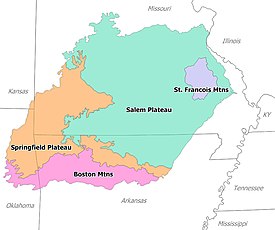
Back Ozarkplato Afrikaans الأوزارك Arabic الاوزارك ARZ Озарк Bulgarian ओजार्क Bihari Ozark Plateau Czech Yr Ozarks Welsh Ozark-Plateau German Ozark-Altebenaĵo Esperanto Meseta de Ozark Spanish
| Ozarks | |
|---|---|
| Ozark Highlands; Ozark Mountains; Ozark Plateaus | |
 View of the Ozarks from the Buffalo National River, Newton County, Arkansas | |
| Highest point | |
| Peak | Wahzhazhe Summit (formerly known as Buffalo Lookout) 781 m (2,561 feet) |
| Coordinates | 37°10′N 92°30′W / 37.167°N 92.500°W |
| Geography | |
| Country | United States |
| States | |
| Geology | |
| Rock age | Paleozoic to Proterozoic |


The Ozarks, also known as the Ozark Mountains, Ozark Highlands or Ozark Plateau, is a physiographic region in the U.S. states of Missouri, Arkansas, and Oklahoma, as well as a small area in the southeastern corner of Kansas.[1] The Ozarks cover a significant portion of northern Arkansas and most of the southern half of Missouri, extending from Interstate 40 in central Arkansas to Interstate 70 in central Missouri.
There are two mountain ranges in the Ozarks: the Boston Mountains of Arkansas and Oklahoma, as well as the St. Francois Mountains of Missouri. Wahzhazhe Summit (formerly known as Buffalo Lookout), is the highest point in the Ozarks at 2,561 feet (781 m), and is located in the Boston Mountains, in the westernmost part of Newton County, Arkansas, 6.2 miles (10.0 km) east of Boston, Madison County, Arkansas. Geologically, the area is a broad dome with the exposed core in the ancient St. Francois Mountains. The Ozarks cover nearly 47,000 square miles (120,000 km2), making it the most extensive highland region between the Appalachians and Rockies. Together with the Ouachita Mountains, the area is known as the U.S. Interior Highlands.
The Salem Plateau, named after Salem, Missouri, makes up the largest geologic area of the Ozarks. The second largest is the Springfield Plateau, named after Springfield, Missouri, nicknamed the "Queen City of the Ozarks". On the northern Ozark border are the cities of St. Louis and Columbia, Missouri. Significant Ozark cities in Arkansas include Fayetteville, Bentonville, Springdale, Eureka Springs, and Fort Smith. Branson, just north of the Arkansas–Missouri border, is a tourist destination where Ozark culture is popularized.
- ^ "Ozark Plateau | GeoKansas". geokansas.ku.edu. Retrieved August 25, 2024.
